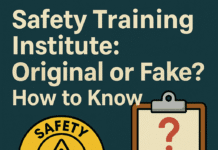
NIOSH: National Institute for Occupational Safety and Health
Introduction
National Institute for Occupational Safety and Health (NIOSH) : Occupational safety and health are paramount concerns in any society. Workers deserve a safe and healthy environment in which to perform their duties. The National Institute for Occupational Safety and Health, commonly known as NIOSH, plays a pivotal role in ensuring just that. In this article, we will delve into the world of NIOSH, its origins, missions, and the tremendous impact it has on the well-being of the American workforce.
The Birth of NIOSH
Established in 1970, NIOSH came into existence under the Occupational Safety and Health Act. Its formation was a response to the urgent need for research and recommendations to prevent workplace injuries and illnesses. NIOSH was created with a clear mandate: to be the nation’s leading authority on occupational safety and health.
NIOSH’s Mission and Goals
At its core, NIOSH is dedicated to ensuring safe and healthy working conditions for all Americans by providing research, information, and education. Its primary goals include conducting scientific research, developing innovative solutions, and disseminating knowledge to reduce occupational hazards. NIOSH strives to be the guiding light in safeguarding workers’ well-being.
The Role of NIOSH in Workplace Safety
NIOSH acts as a compass for workplace safety standards and practices. It conducts extensive research to identify existing and emerging workplace hazards, from chemicals and machinery to ergonomic issues. Armed with this data, NIOSH can recommend best practices and regulations to protect workers.
NIOSH’s Research and Training Initiatives
Research is at the heart of NIOSH’s operations. The institute delves into various industries, studying potential risks and devising strategies to mitigate them. Moreover, NIOSH offers training programs and materials to equip employers and employees with the knowledge and skills needed to promote safer workplaces.
Collaborations and Partnerships
NIOSH recognizes the importance of collaboration in achieving its mission. It partners with organizations, unions, and academic institutions to further its research and initiatives. By pooling resources and expertise, NIOSH can make substantial strides in enhancing occupational safety.
NIOSH’s Impact on Occupational Safety
Over the years, NIOSH’s efforts have borne fruit. Workplace fatalities and injuries have declined significantly, thanks in part to the institute’s recommendations and guidelines. By setting the bar high for safety standards, NIOSH has saved countless lives.
Addressing Emerging Occupational Hazards
The modern workplace continually evolves, bringing new challenges and risks. NIOSH remains vigilant in identifying and addressing these emerging occupational hazards, ensuring that the American workforce stays protected in a rapidly changing world.
NIOSH’s Contribution to Pandemic Response
In recent times, NIOSH has played a pivotal role in responding to global pandemics. The institute’s expertise in respiratory protection and infectious disease control has been invaluable in safeguarding healthcare workers and the general population.
Promoting Worker Health and Well-being
NIOSH doesn’t stop at injury prevention. It also focuses on enhancing workers’ overall health and well-being. Initiatives like Total Worker Health® aim to integrate wellness programs into the workplace, creating environments that nurture physical and mental health.
NIOSH’s International Influence
NIOSH’s impact extends beyond U.S. borders. Its research and expertise are sought after globally, contributing to the improvement of occupational safety and health worldwide. The institute’s influence reinforces America’s commitment to global well-being.
Challenges Faced by NIOSH
Despite its successes, NIOSH faces challenges, such as limited resources and the need to adapt to ever-evolving industries. However, its dedication to its mission keeps it at the forefront of occupational safety.
The Future of Occupational Safety
As workplaces continue to transform, NIOSH’s role becomes increasingly critical. With advancements in technology and industry, the institute’s research and guidance will be vital in ensuring that American workers remain safe and healthy.
Conclusion
In the world of occupational safety and health, the National Institute for Occupational Safety and Health (NIOSH) stands as a beacon of hope. Its commitment to research, education, and collaboration has resulted in safer workplaces and healthier workers. As we look to the future, NIOSH will undoubtedly remain a cornerstone of occupational safety in America.
Occupational Health and Safety Career
JHSC Certification Training (Joint Health and Safety Committee)
Certificate of Recognition Auditor Certification (COR)
NCSO Certification (National Construction Safety Officer)
Fire and Safety Course Government Colleges List
FAQs
- What is NIOSH’s primary mission?
- NIOSH’s primary mission is to ensure safe and healthy working conditions for all Americans by conducting research, providing information, and offering education.
- How does NIOSH contribute to pandemic response?
- NIOSH contributes to pandemic response by leveraging its expertise in respiratory protection and infectious disease control to safeguard healthcare workers and the public.
- Is NIOSH only focused on preventing workplace injuries?
- No, NIOSH also promotes worker health and well-being through initiatives like Total Worker Health®, which integrates wellness programs into the workplace.
- Does NIOSH have an international presence?
- Yes, NIOSH’s research and expertise are recognized globally, contributing to the improvement of occupational safety and health worldwide.
- What are the major challenges faced by NIOSH?
- NIOSH faces challenges such as limited resources and the need to adapt to evolving industries, but its dedication to its mission remains unwavering.





















